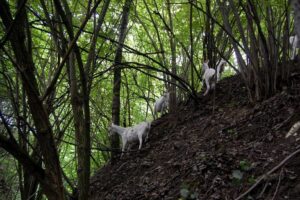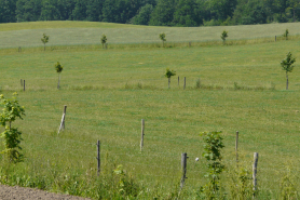Agroforestry in Poland
“Agroforestry” is a term not recognized by agricultural producers and decision-makers in Poland. The extent of agroforestry in Poland is also not known. However, Trees outside Forests (ToF) are considered as an important element of environmental policy, including in-field trees.
Despite this, there is no clear definition for ToF in the country. Shelterbelts systems in Wielkopolskie province and riparian buffers are well known in Poland. There are a number of different social actions aimed at planting trees in rural areas, including initiatives focused on planting old traditional varieties of fruit trees, of which some are used for silvopastoral use. Slow development of extensive farming of beef cattle is observed, in some cases related to sustainable use of wooded grasslands, and introduction of hedgerows or orchard grazing. We can find frequently sheep and goats grazing on wooded pastures, particularly in marginal or less accessible areas. At last, initiatives with alley cropping systems appear, supported by interventions within Common Agricultural Policy after 2023.
- Goats grazing in wooded gully (Lubelskie region)
- Cattle grazing in newly planted traditional orchard (Beskid mountains)
- Sheep grazing on wooded pastures in Gorce mountains
AGROFORESTRY DISSEMINATION IN POLAND
The Polish Agroforestry Association has been established in 2015 and counts 38 members. Most of them are researchers, several are farmers. The association organizes annual meetings and workshops. Beef Cattle Farmers Association “Pastwisko” was established in 2018 and intends to promote and develop silvopastoral systems. Organic Agriculture Forum gathering organic farming experts supports policy of developing agroforestry in the country. Agroforestry Cluster is a commercial organization, supervised by team from ECO – FARM Sosnówka.
There are a number of organizations, dealing with the planting and management of trees in rural areas, but they do not consider themselves agroforestry organizations.
Currently, two University programs are offering agroforestry studies – University of Life Sciences in Lublin and University of Rzeszów. Training services for farmers in agroforestry are also provided by regional agricultural advisory bodies. Research in agroforestry is conducted by IUNG (Institute of Soil Science and Plant Cultivation) in Puławy and University of Life Sciences in Wrocław.
- Alley cropping systems in biodynamic farm (Stanisław Karłowski Foundation, Juchowo Farm, NW Poland)
- Traditional Polish landscape with pollarded willows and cattle
- Limousine cattle enjoy browsing forest (organic farm, Beskid Niski mountains)
Within the 2023-2027 CAP Strategic Plan Policy, financial support is provided for in-field trees outside the forest (field windbreaks) and agroforestry as optional measures for farmers interested in afforestation.
1). establishment of field windbreaks
Establishment of one afforested complex, constituting compact bound surface economically and environmentally, meeting the following rules:
• deliberate area shape for lands planted over 0.5 ha
• width of at least 4 m and not more than 20 m until 0.5 ha area
– only native species of trees or shrubs should be planted, including species significantly improving biodiversity, melliferous species and fruit tres of traditional varieties;
– the species composition of plantings should be dominated by deciduous species, i.e. at least 90%;
– the planting should be carried out with at least 4 different species or types of trees or shrubs, except that the share of trees or shrubs of the least numerous species or genus among the three the most numerous is at least 10%;
– the share of fruit trees shall not exceed 50%;
– the species composition will be adjusted to the habitat, environmental and climatic conditions of the area in question;
– a detailed list of species and types of trees and shrubs for this intervention is defined in national legislation;
– the number of seedlings of trees or shrubs will amount to approx. 1,500-2,500 plants/ha;
– the farmer will be able to consult the planned tree cover with an agricultural advisor, specialized in this regard.
2). establishment of agroforestry systems
The measure is the only official support for agroforestry in Poland, as agroforestry systems are legally qualified as arable land or permanent grassland meeting the conditions defined for Intervention 10.13 “establishment of agroforestry systems”.
Arable land and grassland (excluding grassland in Natura 2000 areas) will be eligible for support, where an agroforestry system will be implemented:
– at least 4 different species or types of trees or shrubs, among which deciduous species predominate, where the share of fruit trees shall not exceed 50%;
– on arable land in alley form (1-3 rows belt within the width 4-10 m at the distance 10-50 m between the rows belts) or on grassland in the silvopastoral form in any arrangement of trees;
– by planting 150 to 250 trees or shrubs per 1 ha;
– trees or shrubs in the agroforestry system shall be protected against damage with shelters or 3 stakes or sheep wool or repellents.
Both measures could receive a 5-year yearly premium in order to compensate for maintenance costs of intervention (Premium for maintenance of forest, of field windbreaks and of agroforestry). Organic farms and land under CAP agri-environmental support (including ecoschemes) shall be excluded from the above support for agroforestry establishment.
Overall, there is still little knowledge about agroforestry among experts and practitioners. Physical conditions are difficult for farming in Poland: in the majority of farms with poor soil quality, low size and high fragmentation of farms/parcels. This restricts agroforestry to marginal areas, and large fields in more agroforestry-friendly farms. Moreover, grazing animals in the forest is prohibited under regulations from the 1940s. Planting non-native trees is prohibited under the Act on aline species of 2021, even though these species are already ubiquitous and it would not affect their spread. Additionally, sanitary regulations make small scale food production very difficult. Despite these barriers, many farmers have embarked on investments in agricultural systems, often outside the official agricultural policy support system. Every year there are more and more field experiments and new initiatives (small-scale plantations, forest gardens, hedgerow plantings), which will provide a good basis for the development of alternative products as well as for the dissemination of agroforestry knowledge itself.
LEARN MORE ABOUT AGROFORESTRY IN POLAND





